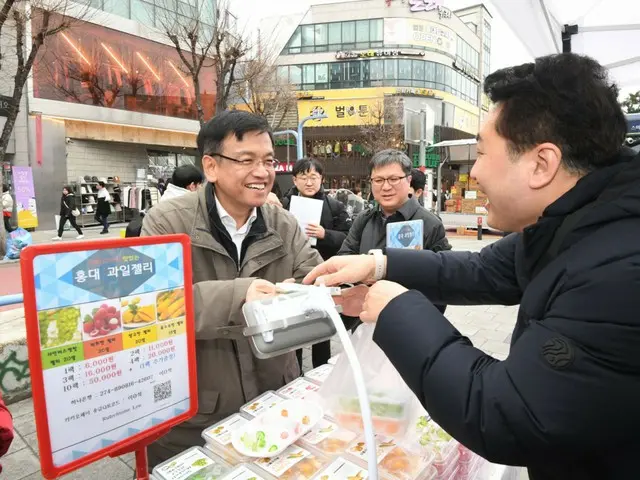We need to spread the word to all sectors and do our best to restore the people's livelihood and economy." Choi emphasized ``recovery of the people's economy'' as the first task of the second-term economic team of the government.
This is because the economy is in dire straits. Last year, South Korea recorded a trade balance deficit of $9.97 billion. This is the second consecutive year of deficit following 2022. However, last year, the size of the trade balance deficit in 2022 was 4.
This was down from $7.78 billion. Although exports have finally recovered in the second half of the year, there are still no signs of recovery in domestic demand.
In South Korea, the growth rate of domestic private consumption in the third quarter (July-September) of last year was only 0.2% compared to the same period last year. Increase in domestic private consumption
The rate maintained a high rate of increase until the first quarter of last year (4.6%), but fell to 1.5% in the second quarter and 0% in the third quarter. 2 years 3 since plummeting 6.4% in Q4 2020
Lowest in a quarter. This is serious even when compared internationally. It is also below the Organization for Economic Development and Cooperation (OECD) average (1.5%). USA, UK, Germany, France, Japan, Italy, Kana
The average consumption growth rate in the G7 countries, including South Korea, was 1.2%, six times that of South Korea. This appears to be due to the full-scale effects of high interest rates and high prices. In fact, it will be 1.25% in January 2022.
The base interest rate rose sharply to 3.5% in January 2023, and remained at a high rate of 3.5% throughout the year. The balance of household credit (household debt) in the third quarter of last year was 1,875.6 trillion won, compared to the previous quarter.
It was revealed that the amount increased by 0.8% (14.3 trillion won) from the quarter. It increased for the second consecutive quarter following the second quarter (0.4%), and the rate of increase was approximately twice as large. In particular, household loan arrears
The rate has also maintained an upward trend since the second half of last year. The delinquency rate was 0.66% in December 2022, rose to 0.76% in January last year, and jumped to 0.95% in August. September is also 0.89
% is recorded. Prices in Korea have risen alarmingly. Last year, the year-on-year increase in the consumer price index was 3.6%. Although it has slowed down from last year's 5.1%, it has entered an inflationary phase since the coronavirus pandemic.
This is 1.1 percentage points higher than the 2.5% recorded in 2021. Before the coronavirus pandemic, the consumer price index increase rate from 2016 to 2018 was in the 1% range, and in 2019 it was 0.4%. This year's price increase
The rate exceeds the Bank of Korea's target of 2%. This is also 0.3 percentage points higher than the 3.3% inflation rate predicted by the Korean government for the second half of last year.
The blow to the people was also great. Prices of items essential to daily life, such as "food" and "electricity, gas, and water," have sharply increased.
Rose. In fact, among consumer prices last year, the price increase rate for processed foods, a representative food index, was 6.8%, 1.9 times the overall rate (3.6%). The rate of increase in outside food prices is also 6%, 1.7
Survey results show that twice as much. This means that the price burden on food, such as processed foods and eating out, was higher than on other items. In addition, the prices of electricity and city gas will rise,
Prices for electricity, gas, and water have also increased by 20% from last year. On the other hand, wages have not kept up with prices. In fact, the average monthly nominal wage from January to October this year was 3,943,000 won.
Although the increase was 2.7% compared to the same period last year, the consumer price inflation rate for the same period was 3.7%, and real wages, which reflect inflation, actually fell by 1%. Even if nominal wages rise due to high prices, they do not actually increase.
do not have. Real wages started falling again last month after increasing for the first time in seven months. Disposable income that can be used for consumption and savings after excluding interest and taxes from overall income is 3,931,000 won, and the price increase rate is 3,931,000 won.
(3.6%), an increase of only 1.2%. The problem is that consumption is unlikely to recover this year. The Bank of Korea has presented this year's private consumption growth rate as 1.9%. last
The level is similar to that of 2017. In its economic outlook for 2024, the Korea Development Institute (KDI) said, ``Private consumption is expected to increase by 1.8%, the same as the previous year (1.9%), as product consumption continues to be sluggish due to high interest rates.
"It's going to stay," he predicted. Furthermore, there is even a liquidity crisis in real estate project finance (PF), with Tae Yeon Construction applying for a workout (corporate structure improvement work).
It's the situation. Construction investment will account for around 15% of gross domestic product (GDP) in 2022, and a slump in the construction economy could further weaken the already cold economy.
2024/01/03 06:00 KST
Copyrights(C) Herald wowkorea.jp 104

